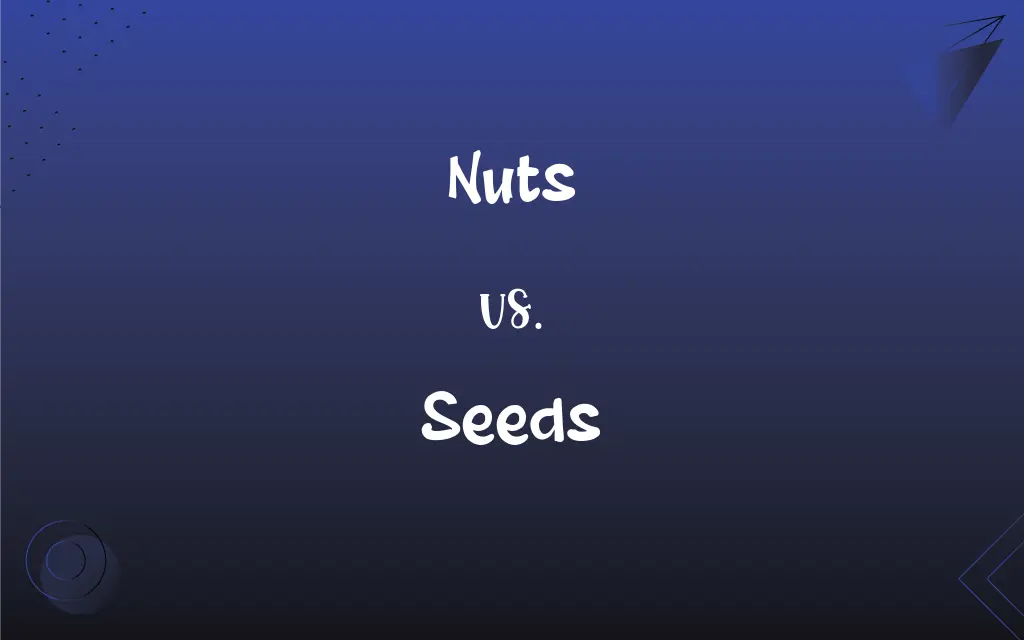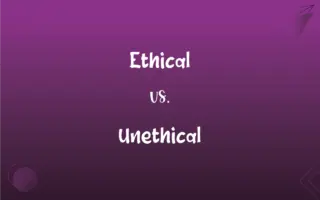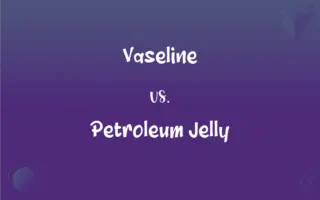Nuts vs. Seeds: What's the Difference?
Edited by Aimie Carlson || By Harlon Moss || Updated on October 10, 2023
Nuts are hard-shelled fruits that don't split open to release their seed, while seeds are embryonic plants enclosed in an outer covering.

Key Differences
Nuts and seeds are both integral parts of plants, but they have distinct roles and characteristics. Nuts are typically the hard-shelled fruits of certain plants, protecting a seed inside, while seeds are the embryonic stage of a plant contained within a protective outer layer.
While many nuts are consumed for their delicious taste and nutritional benefits, it's essential to note that not all edible seeds are considered nuts. Conversely, seeds span a vast range, from tiny sesame seeds to larger variants like sunflower seeds.
A key botanical distinction is that nuts are indehiscent, meaning they don't naturally split open to release their seed. In contrast, many seeds are found in fruits that split open when they mature, making the seed accessible for germination.
When considering culinary applications, the terms nuts and seeds sometimes blur, as certain seeds are popularly termed as nuts. For example, while almonds are botanically seeds, they're widely recognized as nuts in the kitchen.
Both nuts and seeds offer a plethora of health benefits. They're rich in essential nutrients, fats, and proteins. However, it's crucial to differentiate between the two when discussing specific dietary or botanical points.
ADVERTISEMENT
Comparison Chart
Botanical Definition
Indehiscent fruits
Embryonic plants enclosed in an outer covering
Splitting Characteristic
Don't naturally split to release their seed
Often found in fruits that split open upon maturity
Edibility
Many are edible and nutritious
Vast range are edible with varying nutritional values
Example
Almonds (though botanically a seed)
Sunflower seeds
Culinary Usage
Often used in cooking, baking, and snacking
Used for oil extraction, cooking, and garnishing
ADVERTISEMENT
Nuts and Seeds Definitions
Nuts
Indehiscent plant products.
Hazelnuts, like most nuts, don't split open to release their seeds.
Seeds
Beginnings of a new plant life.
From tiny seeds, towering trees grow.
Nuts
Edible and nutritious fruits.
Brazil nuts are a rich source of selenium.
Seeds
Found in many fruits and vegetables.
The watermelon was packed with black seeds.
Nuts
Botanically distinct from seeds.
While people enjoy almonds as nuts, they are botanically seeds.
Seeds
Essential for plant reproduction.
The dispersal of seeds ensures the continuation of plant species.
Nuts
Hard-shelled fruits protecting a seed.
Walnuts are one of the popular types of nuts consumed globally.
Seeds
Embryonic plants within protective coverings.
The farmer planted tomato seeds in the spring.
Nuts
Often used in culinary applications.
The chef garnished the dessert with finely chopped nuts.
Seeds
Often consumed for their nutritional benefits.
Chia seeds are rich in omega-3 fatty acids.
FAQs
Are all nuts edible?
No, while many nuts are edible, some can be toxic.
Do seeds always come from fruits?
Most seeds develop from fruits, but not all fruits contain seeds.
Can seeds be harmful?
While many seeds are beneficial, some can be toxic or cause allergies.
What defines seeds?
Seeds are embryonic plants enclosed in an outer covering, ready to germinate.
Why don't nuts naturally split open?
Nuts are indehiscent, meaning they have a protective nature to shield the seed inside.
Why are nuts nutritious?
Nuts are rich in proteins, fats, vitamins, and minerals.
Why do seeds have coatings?
The outer coating protects the embryonic plant and aids in dispersal.
Which nuts are tree nuts?
Almonds, walnuts, and cashews are examples of tree nuts.
What is the primary purpose of nuts in nature?
Nuts protect and provide nutrients to the seeds inside them.
Are coconuts considered nuts?
Botanically, coconuts are drupes, but they're often referred to as nuts.
How are seeds used in cooking?
Seeds can be used for oil extraction, garnishing, or as ingredients.
Can seeds be used to produce oil?
Yes, seeds like sunflower and sesame are commonly used to extract oil.
Why are seeds vital for plants?
Seeds play a pivotal role in plant reproduction and species continuation.
How are seeds dispersed?
Seeds can be dispersed by wind, water, animals, or other means.
Are sunflower seeds true seeds?
Yes, sunflower seeds are true seeds.
What are nut allergies?
Some people have immune reactions to proteins in certain nuts, causing allergies.
What are nuts?
Nuts are hard-shelled fruits that don't split open to release their seeds.
What is the most consumed nut globally?
Almonds are among the most consumed nuts worldwide.
Are peanuts true nuts?
No, peanuts are legumes, but they are called nuts for culinary purposes.
How do seeds germinate?
With the right conditions of moisture and temperature, seeds begin to sprout.
About Author
Written by
Harlon MossHarlon is a seasoned quality moderator and accomplished content writer for Difference Wiki. An alumnus of the prestigious University of California, he earned his degree in Computer Science. Leveraging his academic background, Harlon brings a meticulous and informed perspective to his work, ensuring content accuracy and excellence.
Edited by
Aimie CarlsonAimie Carlson, holding a master's degree in English literature, is a fervent English language enthusiast. She lends her writing talents to Difference Wiki, a prominent website that specializes in comparisons, offering readers insightful analyses that both captivate and inform.































































